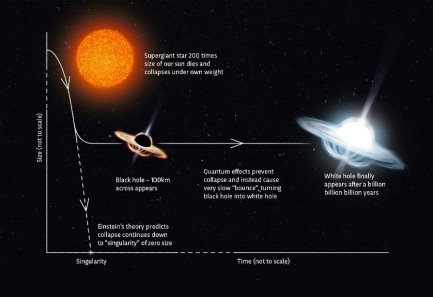In the article, the author writes about the principles of the existence of White holes and compares them with Black holes.
Keywords: astronomy, astrophysics, White holes, Black holes, Universe.
How often do you catch yourself thinking about the appearence of the Universe? Do we liturally exist? What does our world consist? You are bothered with all these thoughts quite often, I guess. Endlessness of questions are all over us, therefore in this article I am going to try to open you one of the secrets of the Universe: the existence of White holes. Surely, at least once have you heard or noticed the article about the discovering of Black holes. However, what about their neglected twins? Let's investigate!
First and foremost, we should come back to the 19th century, when humanity mentioned the possibility of White holes existence for the first time (I should mention, only theoretically) (picture 1). The idea of «Black holes opposites» existence was put forward not so far — only in 1964 (just for comparison, Black holes were firstly mentioned in history in the 18th century). This theory dawned on the Russian cosmologist Igor Novikov [3].

Pic. 1. Prediction of a White hole's look
The idea about these mysterious consists of the Universe went from the different solutions of the Einstein field equations. In 1915, Einstein turned the world of physics on its head. His theory of relativity describes the force of gravity and shattered the prevailing paradigm of the nature of reality — rather than being rigid, space and time can actually bend and fold, along with the mass of stars and planets. In general relativity a White hole is a hypothetical region of spacetime and singularity. The main point about its existence is that nothing is able to enter from the outside, however, it can only escape (for instance, energy-matter, light and quantum information).
According to this fact, we can notice that we are talking about the total opposite of a Black hole, but even they still have something in common. Literally, even the idea of the existence of White holes appeared from the theory of Black holes. Obviously, that is not surprising that they even have the same properties (at all, they are reciprocal in structure): mass, charge, and angular momentum. Like any other mass they attract matter, but instead of reaching the event horizon, they will never able to do (the event horizon is the point of no return — nothing that crosses the event horizon can ever come back — even light cannot escape once it’s passed the event horizon: once something has crossed the event horizon, they will begin the inevitable process of falling towards a Black hole’s singularity, eventually dissolving into the singularity itself).
Moreover, like a Black hole, a White hole might be huge or tiny, might spin or remain stationary, and even might be electrically charged. A White hole would also be surrounded by a ring of dust, and a cloud of gas and debris would gather at its event horizon.
The key difference between a Black hole and a White hole is that the second one burps. Unlike a Black hole, from which nothing can escape, matter actually can cross the event horizon and come out of a White hole. If a Black hole’s event horizon is the point of no return, then the event horizon of a White hole could be described as the point of no admission — nothing can ever cross the event horizon of a White hole and reach the interior. In a Black hole, objects in the space outside can cross the event horizon and affect the interior of a Black hole, but matter inside a Black hole can never again interact with space outside. In a White hole, the reverse holds true — objects from inside a White hole can cross the event horizon and interact with objects in the space outside of it, but nothing of the outside can ever enter a White hole or affect the inside. This is because a White hole is a Black hole’s time reversal, according to physicists. A Black hole’s singularity exists in the future, whereas a White hole’s exists in the past. Since the interior of a White hole is cut off from the Universe’s past via its event horizon, no outside object or event will ever affect the inside of a White hole [1].
By the way, according to that total opposite, the theory about Wormholes was appeared by scientists. The main idea is that Black and White holes can be theoretically connected with a “tube”, where the physics laws don’t exist at all (the same as in holes). If the theory was justified, it would mean that these Wormholes are the “portals” to different Universes (realities) and the speed in them can exceed even the speed of light (picture 2). This idea was greatly explained in the movie Interstellar.

Pic. 2. The theory of Wormholes
A spherical mass shrunken down to infinitely dense point could wrap space around it so tightly that a region of space is effectively pinched off from rest of the Universe, creating a no-man’s land beyond the event horizon where the laws of physics no longer apply and the link between cause and effect is shattered. A Black hole is an incredibly dense area of space where all matters has been squeezed into an impossibly tiny space, called the singularity. This creates such an intense gravitation pull that nothing, not even light, can escape from a Black hole’s clutches.
Objects falling towards a White hole would never actually achieve the hole. It could be compared to a gravitational field, but without a surface. It depends on the acceleration due to gravity is the greatest on the surface of any body. But since White holes lack a surface, acceleration due to gravity increases, but never reaches a final value.
Overall, depends on these differences of Black and White holes, it is obvious that they do contradict each other (totally opposite expanses cannot exist in one field). According to this, scientists ended up with the idea that supermassive White holes could be theoretically formed in the center of a supermassive Black hole (humanity predicts that especially Black holes are located in the centers of galaxies and even of our Universe as well). The first one who decided that this theory could work out was Stephen Hawking, who proposed that supermassive Black holes spawn a supermassive White hole as well.
However, they cannot be born just somewhere in the Universe, therefore, especially to explain the specific behavior for their birth, in physics the term «spacetime» exists (spacetime is a mathematical model that combines the three dimensions of space and one dimension of time into a single four-dimensional manifold). At all, the concept is that spacetime should have no boundaries and “edges” to allow particles that come out of White holes and enters to move infinitely long and far.

Pic. 3. The birth of a White hole
Nowadays, White holes exist only theoretically for humanity. They were noticed on the firmament not even ones by astrophysicists, however, their existence was never proved by photos. Thus, a huge amount of work has been spent on study of White Holes. Despite that, why is the fact of the existence of this astronomical mystery so important to people? Its significance for humanity is quite great, and study of White and Black holes has long ceased to be a problem only for astrophysicists. Thousands of scientists around the world are working on the study of mystery in order to find out the secret of its origin and existence. Because by discovering the answer to this one of the most difficult questions of astrophysics, humanity will make tremendous progress towards understanding our world and its creation. This will be a huge, invaluable contribution to science, which will open up completely new horizons for further study of the structure of the Universe [2].
References:
- Matthew Bothwell The invisible universe. — М.: Oneworld, 2022.
- Alexander Dementiev Popular astrophysics. — М.: АСТ, 2022.
- https://en.wikipedia.org/wiki/White_hole










